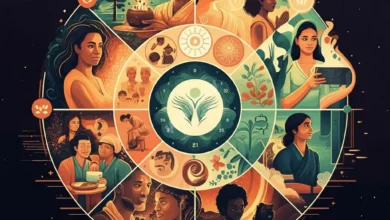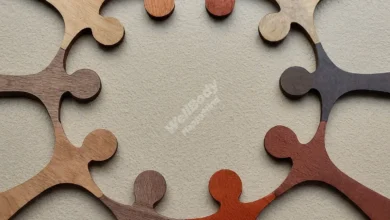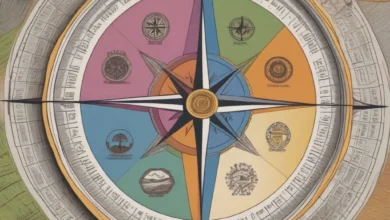Community Choreography: Building Social Wellness and Unity

Introduction
Have you ever watched a group dance performance and marveled at how each dancer moves in perfect harmony with the others? This beautiful synchronization isn’t just for the stage – it’s a powerful metaphor for how we can build stronger, healthier communities. Welcome to the world of community choreography, where the steps we take together lead to greater social wellness and unity.
In today’s fast-paced world, it’s easy to feel disconnected. But research shows that strong community bonds are crucial for both individual and collective well-being. Like dancers in a well-choreographed routine, when we move together with purpose, we create something truly extraordinary.
The Rhythm of Social Connections
Understanding Social Wellness
Social wellness is more than just having friends. It’s about creating meaningful connections and contributing to your community. Here are the key components:
- Healthy relationships with family, friends, and neighbors
- Effective communication skills
- Respect for yourself and others
- Community involvement and support
- Conflict resolution abilities
- Empathy and understanding for diverse perspectives
When these elements come together, they create a rhythm that supports our overall health and happiness.
The Impact of Community on Mental Health
The link between strong community ties and better mental health is clear. Studies show that people with robust social connections are less likely to experience depression and anxiety. They also tend to have higher self-esteem and a greater sense of purpose.
For example, a 2019 study published in the Journal of Epidemiology and Community Health found that individuals who felt a strong sense of belonging to their local community reported significantly better mental health outcomes.
Steps to Foster Community Unity
Active Participation in Local Events
Getting involved in your community is easier than you might think. Here are some ideas to get you started:
- Attend neighborhood meetings or town halls
- Join a local sports team or fitness class
- Participate in community clean-up days
- Attend cultural festivals or art shows
- Support local farmers’ markets
- Join a book club at your local library
Each of these activities is a step in the dance of community building, bringing you closer to your neighbors and strengthening the social fabric.
Volunteering and Community Service
Volunteering is a powerful way to contribute to your community while boosting your own well-being. When you give your time and skills to help others, you’re not just making a difference in their lives – you’re improving your own mental and physical health too.
Research published in the journal BMC Public Health found that volunteers report lower levels of depression, increased life satisfaction, and enhanced well-being. Plus, the social connections you make while volunteering can lead to lasting friendships and professional opportunities.
Here are some local volunteer opportunities to consider:
- Food banks or soup kitchens
- Animal shelters
- Senior centers
- Youth mentoring programs
- Environmental conservation projects
- Local museums or historical societies
Creating Inclusive Spaces
A truly unified community embraces diversity and inclusivity. When everyone feels welcome and valued, the community thrives. This means creating spaces and events that are accessible and appealing to people of all ages, backgrounds, and abilities.
Here are some tips for promoting inclusivity in community settings:
- Use inclusive language in all communications
- Ensure physical accessibility for people with disabilities
- Offer multilingual resources when possible
- Plan events at various times to accommodate different schedules
- Seek input from diverse community members when planning activities
- Celebrate different cultures and traditions throughout the year
By following these steps, you’ll be choreographing a community dance where everyone has a part to play, creating a beautiful performance of unity and social wellness.
The Choreography of Community Building
Identifying Community Needs
Just as a choreographer must understand the strengths and limitations of their dancers, effective community building starts with recognizing the unique needs of your area. Here are some methods for assessing community requirements:
- Conduct surveys online or in-person
- Host focus groups with diverse community members
- Analyze local data on health, education, and employment
- Observe public spaces and community gatherings
- Engage with local leaders and organizations
- Monitor social media discussions about local issues
Collaborative Problem-Solving
Once you’ve identified community needs, it’s time to bring people together to find solutions. Organizing community meetings is a great way to start. Follow these steps:
- Choose an accessible venue and convenient time
- Invite a diverse group of community members
- Prepare a clear agenda and share it in advance
- Assign a neutral facilitator to guide the discussion
- Encourage all voices to be heard
- Document ideas and action items
- Follow up with participants after the meeting
When it comes to group decision-making, consider techniques like consensus building or dot voting. These methods help ensure that everyone feels their opinion matters. Remember, the goal is to create a choreography where every community member has a role to play.
Celebrating Community Achievements
Recognizing progress is crucial for maintaining momentum. It’s like applauding after a successful dance performance – it energizes and motivates everyone involved. Here are some ideas for community celebration events:
- Annual awards ceremony for local volunteers
- Community picnic or potluck dinner
- Public art unveiling showcasing local talent
- Neighborhood improvement before-and-after photo exhibition
- Cultural heritage festival honoring community diversity
- Fundraising gala for a local cause
Overcoming Obstacles in Community Dance
Addressing Conflicts and Disagreements
Even the most harmonious dance troupes face occasional missteps. In community building, conflicts are natural but can be managed constructively. Try these conflict resolution strategies:
- Listen actively to all parties involved
- Identify common ground and shared goals
- Use “I” statements to express concerns without blame
- Brainstorm solutions together
- Seek compromise that addresses everyone’s needs
- Follow up to ensure the resolution is working
Bridging Generational Gaps
A thriving community includes members of all ages, each bringing unique perspectives and skills. Here are tips for creating intergenerational connections:
- Mentorship programs pairing seniors with youth
- Skill-sharing workshops led by community members of various ages
- Oral history projects capturing stories across generations
- Intergenerational book clubs or discussion groups
- Community garden projects involving all age groups
- Technology classes where youth teach older adults
Maintaining Momentum and Engagement
Keeping the community dance going requires ongoing effort and creativity. To maintain long-term involvement:
Rotate leadership roles to prevent burnout and bring in fresh ideas. Regularly seek feedback from community members to ensure activities remain relevant and engaging. Celebrate small wins along the way to keep motivation high. Adapt to changing needs by staying flexible in your approach. Finally, keep communication channels open through newsletters, social media, or community bulletin boards to keep everyone in step with community happenings.
Remember, building a strong community is an ongoing process. Like a well-rehearsed dance, it requires practice, patience, and a willingness to learn and adapt. By working together and staying committed to the choreography of community building, you can create a beautiful performance of social wellness and unity that benefits everyone involved.
The Health Benefits of Community Engagement
Physical Health Improvements
Engaging in community activities isn’t just good for social wellness—it can boost your physical health too. Research published in the American Journal of Public Health found that people who volunteer regularly have lower mortality rates and better self-reported health than those who don’t. This might be due to increased physical activity, reduced stress, and a stronger sense of purpose.
Mental and Emotional Well-being
The positive impact of community involvement on mental health is significant. Here are some key psychological benefits:
- Reduced risk of depression and anxiety
- Increased self-esteem and confidence
- Better stress management skills
- Enhanced sense of belonging and purpose
- Improved cognitive function, especially in older adults
- Greater life satisfaction and overall happiness
Social Support Networks
Building strong social ties through community engagement creates a safety net that can help you weather life’s challenges. A robust social support network offers:
- Emotional support during difficult times
- Practical help with daily tasks or emergencies
- Information and advice from diverse perspectives
- A sense of belonging and community identity
- Opportunities for personal growth and learning
These connections act like a sturdy foundation in your life’s dance, providing stability and support as you move through various routines and challenges.
Technology and Virtual Communities
Online Platforms for Community Building
In today’s digital age, virtual communities play an increasingly important role in social wellness. Here are some digital tools and their uses:
- Social media groups: Connect with locals who share your interests
- Neighborhood apps (e.g., Nextdoor): Share local news and resources
- Video conferencing platforms: Host virtual community meetings or events
- Online forums: Discuss local issues and exchange ideas
- Community calendars: Coordinate and promote local events
- Crowdfunding websites: Rally support for community projects
Balancing Online and Offline Engagement
While digital tools can enhance community building, it’s crucial to maintain a healthy mix of virtual and in-person interactions. Here are tips for striking the right balance:
- Use online platforms to plan offline meetups
- Limit screen time and prioritize face-to-face interactions
- Participate in both virtual and physical community events
- Use technology to enhance, not replace, in-person relationships
- Be mindful of digital fatigue and take breaks when needed
- Ensure digital communities are inclusive and accessible to all
Remember, technology should serve as a bridge to real-world connections, not a barrier. The most vibrant communities often blend online and offline engagement seamlessly, creating a rich tapestry of social interactions.
By leveraging both traditional and digital methods of community building, you can choreograph a dynamic dance of social wellness that adapts to the changing rhythms of modern life. This flexible approach ensures that everyone, regardless of their technological comfort level, can participate in the community’s performance.
As we continue to navigate the complexities of building strong, unified communities, it’s clear that the dance of social wellness requires both time-honored steps and innovative moves. By embracing this holistic approach, we can create communities that are resilient, supportive, and truly thriving.
Conclusion: Stepping Together Towards a Brighter Future
As we reach the final steps in our exploration of community choreography, it’s clear that the dance of social wellness and unity is both beautiful and powerful. Just like a well-choreographed performance, a thriving community requires dedication, practice, and harmony among its members.
Let’s recap the key movements in our community dance:
- Understanding social wellness and its impact on mental health
- Fostering community unity through active participation and inclusivity
- Collaboratively addressing community needs and celebrating achievements
- Overcoming obstacles with effective communication and intergenerational connections
- Reaping the health benefits of strong community engagement
- Leveraging technology to enhance, not replace, real-world connections
Each of these steps contributes to a stronger, more resilient community fabric. By engaging in this choreography, we not only improve our own lives but also create a ripple effect of positivity that touches everyone around us.
Your Role in the Community Dance
Now, it’s time for you to take center stage in your community’s performance. Here’s how you can start:
- Identify one community activity you can join this week
- Reach out to a neighbor you don’t know well and start a conversation
- Attend a local event or volunteer for a cause you care about
- Share your skills or knowledge with others in your community
- Use social media to connect with local groups and stay informed about community happenings
Remember, every step you take towards community engagement, no matter how small, contributes to the grand choreography of social wellness and unity.
The Ongoing Performance
Building a strong, unified community is not a one-time performance—it’s an ongoing dance that evolves with each passing day. As you continue to engage with your community, you’ll find that the steps become more natural, the rhythms more familiar, and the joy of dancing together more profound.
So, let’s lace up our dancing shoes and step onto the community stage. Together, we can create a masterpiece of social wellness that resonates far beyond our individual lives. After all, when we move in harmony with those around us, we don’t just dance—we soar.
Your community is waiting for you to join the dance. What will your first step be?



